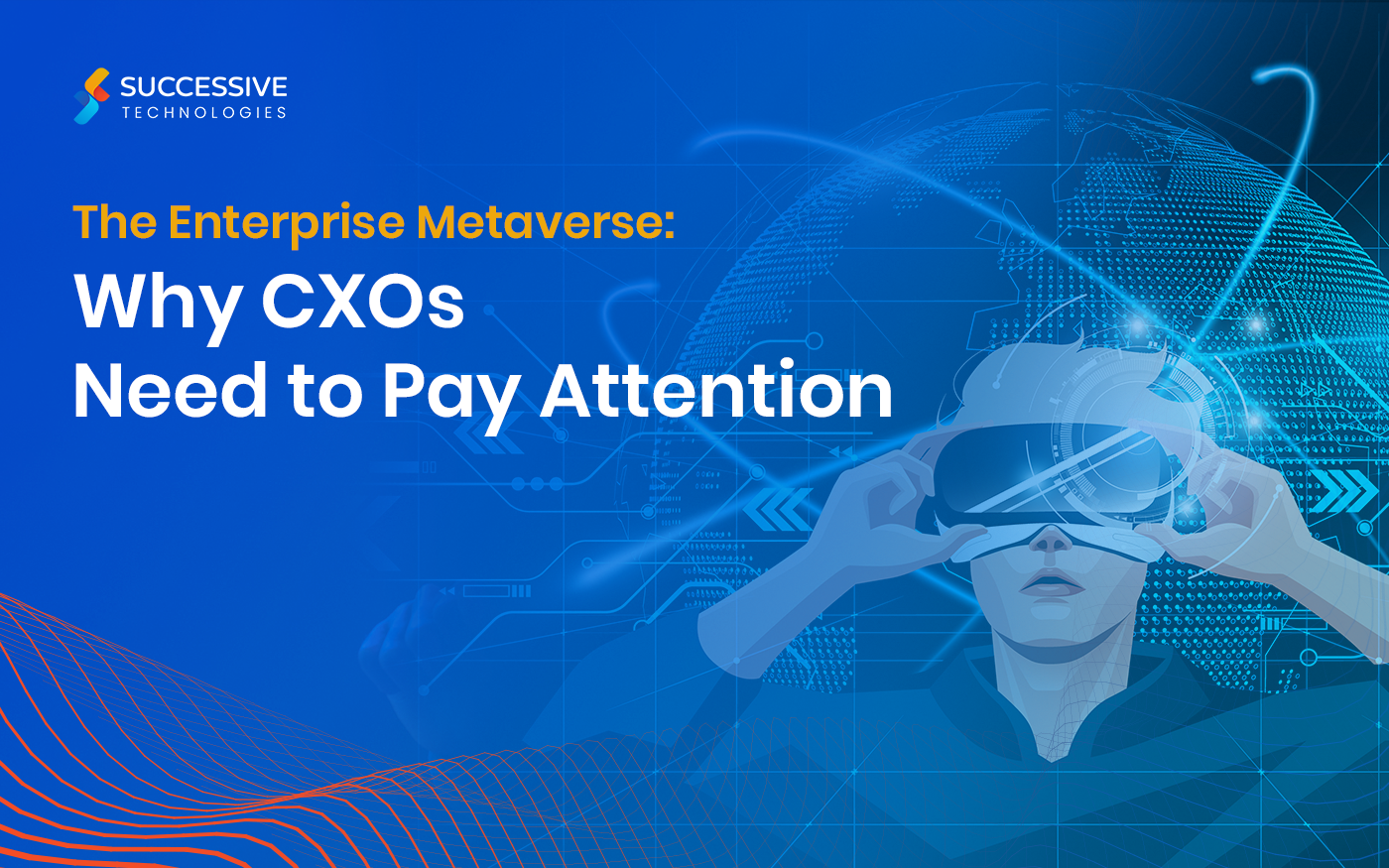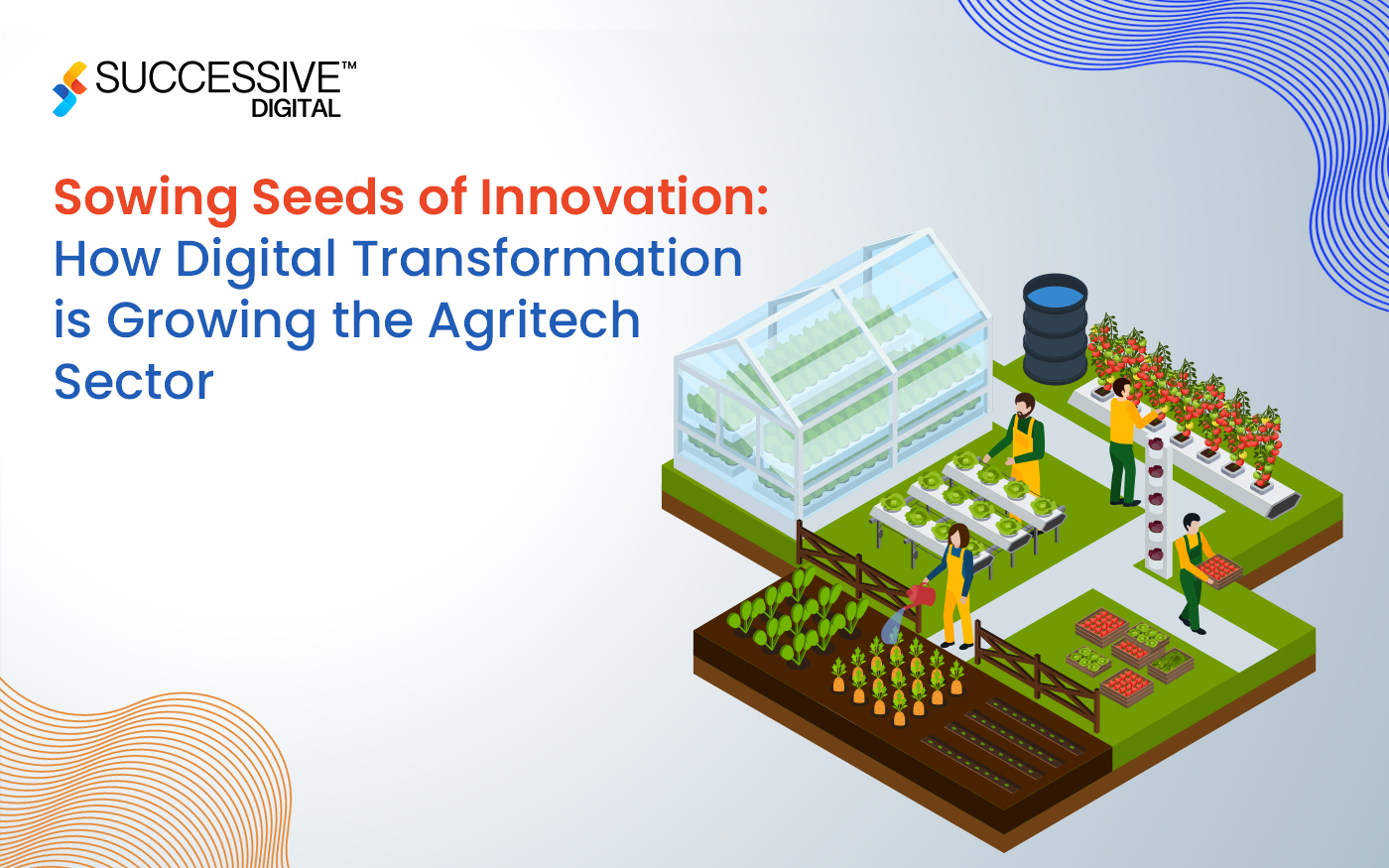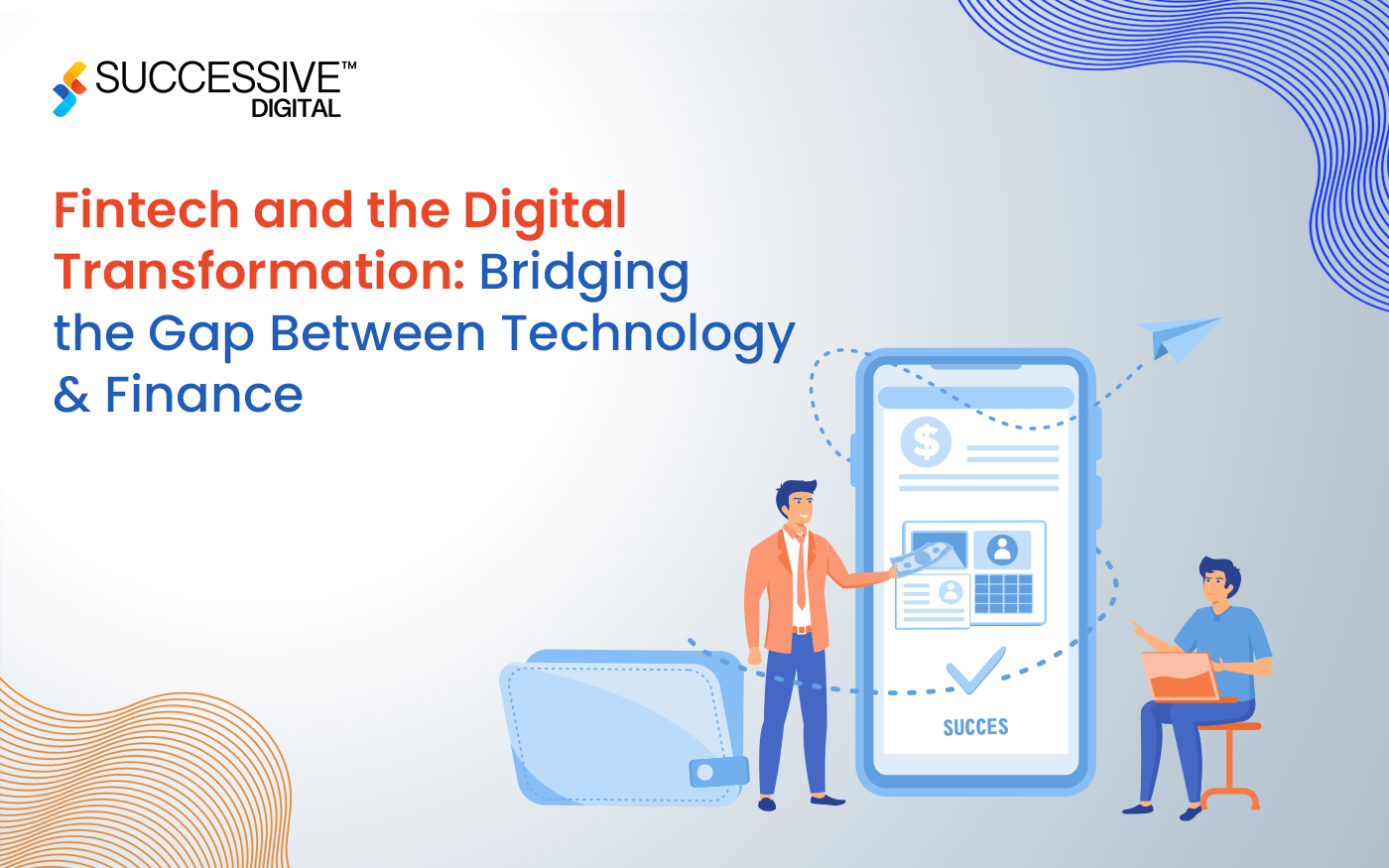With the advancement of technology, the world has changed its way of functioning, and so have humans. It’s very important to be updated and relevant in order to survive in today’s world; the same goes with our software and applications.
Businesses rely significantly on software applications to drive operations, customer experiences, and innovation. However, with time, applications might become outdated, ineffective, and unable to meet the needs of advancing technologies.
But with the help of legacy application modernization services, existing applications can be updated, optimized, and transformed to better suit changing business needs, be more secure, perform better, and be compatible with modern technological standards. This blog will serve as a guide to application modernization services and how to modernize legacy systems.
Understanding Legacy Applications
Legacy applications or software systems are computing systems that have been used by organizations for a long time. These applications or systems were created utilizing dated technologies, architectures, and programming languages, which may now be considered old or not supported by the latest trends and technologies. Although legacy applications have historically been essential to enterprise operations, they can become challenging when technology advances.
What are the Challenges of Legacy Applications?
It’s very evident that organization faces multiple challenges as legacy systems become outdated with time, some of which are given below:
- Outdated Technology: Legacy applications are created using older frameworks and programming languages. These systems don’t support advanced technologies and aren’t compatible with new innovations.
- Maintenance: Finding developers skilled in outdated languages and frameworks becomes more and more challenging as technology advances, causing longer development periods and higher maintenance expenses.
- Scalability: Increased workloads may be difficult for legacy applications to handle, which could affect performance and responsiveness.
- Integration: It can be difficult and error-prone to integrate dated application with more modern systems, APIs, and technologies.
- Security: Legacy applications are possible targets for cyberattacks since outdated technology is more susceptible to security breaches.
- User Experience: Users may encounter outdated features and poor user interfaces, which will reduce their efficiency and satisfaction.
Why do You Need to Modernize Your Legacy Systems?
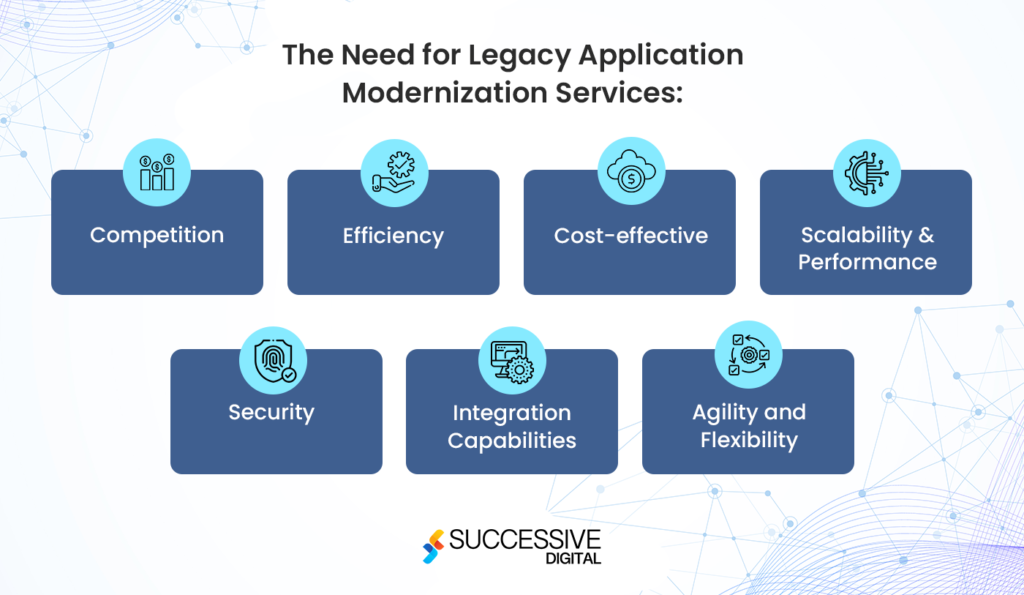
As a business, you always want your system up and running, to accommodate user needs irrespective of time in a day. You never know when user spike on your system. If your applications or systems are not designed to accommodate user needs, it directly impacts your ROI. Modernizing legacy application with new technologies and infrastructure allows you stay relevant to your target user’s needs and ahead of your competitors. Here are the advances of legacy application modernization services that you can leverage:
Competition: To stay competitive, businesses must keep up with technological changes. By updating legacy apps, you can make sure they can take advantage of cutting-edge technology and excellent functionality.
Efficiency: Modernized software reduces manual workarounds and streamlines procedures, making it more effective.
Cost-effectiveness: Legacy applications can have high maintenance and support costs. Through resource optimization and downtime reduction, modernization can result in long-term cost reductions.
Scalability and Performance: Applications that have been modernized may scale to handle rising workloads, guaranteeing continuous performance even as the business expands.
Security: Modernization can introduce new security measures and address security flaws, protecting sensitive and important data.
Agility and Flexibility: Applications that have been modernized can quickly adapt to shifting client needs, market conditions, and corporate requirements.
Don’t Let Legacy Systems Hold You Back: Modernize Your Systems Today!
Our certified development team will pick best trends for your product and smoothly implement them
Enterprise App Modernization
The process of updating, optimizing, and altering software applications that are essential to the operations, procedures, and workflows of organizations is known as enterprise app modernization.
These applications could be obsolete, ineffective, or incompatible with current technological norms and innovation. Enterprise application modernization services cover a variety of approaches and methods to update applications, bringing them into line with present business requirements, utilizing cutting-edge technology, and enhancing their general functionality, scalability, security, and user experiences. Having this process in place, you can have composable applications which can be updated and re-deployed in real-time for better agility and efficiency. Let’s explore many ways to modernize enterprise applications.
How Does It Differ From General App Modernization?
Despite having similar goals, enterprise app modernization and general app modernization differ depending on the application size and its complexity, investment required, time to design and develop an application, and availability of skilled resources. Since cloud-based development and deployment has become crucial for the survival of enterprise solutions, enterprise app modernization is a way complex process than general app modernization. Let’s have a look at a differentiation table and understand the intricacies of both:
| Factors | General App Modernization | Enterprise App Modernization |
| Scope and Complexity | Less Complex and Easy to Handle | Has a wider scope and greater complexity. Numerous related modules and thorough integrations are frequently involved. |
| Integration Challenges | Has fewer issues with integrations | Need for Robust Integration Planning and Execution |
| Regulatory Compliance | It doesnt have specific set of rules | It has specific set of rules for modernization services |
| Legacy Codebase | The codebase can be different depending on the size of the application. For example an startup will have a less complex legacy code base. | Enterprise software frequently has a larger legacy codebase. For example- A company like Shopify will have a larger codebase as compared to any other small enterprise. |
While both enterprise app modernization and general app modernization aim to enhance performance, user experiences, and alignment with contemporary technologies, enterprise app modernization specifically considers the distinctive complexity and vitality of applications within large organizations.
The Process of Application Modernization
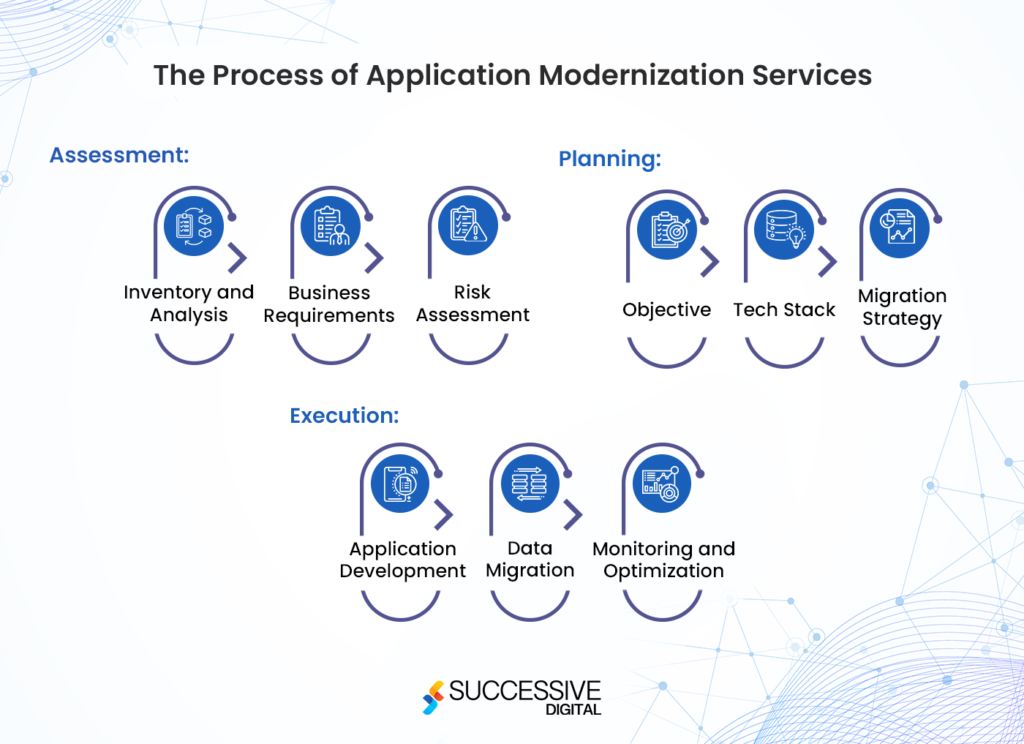
The process of application modernization services involves three steps, below is a detailed explanation for each one of them:
Assessment:
This is the first step that aims to develop a thorough understanding of the current applications, including their architecture, functionality, pain spots, and alignment with business goals. This phase includes:
- Inventory and Analysis: Compile a thorough inventory of all apps, including their versions, dependencies, and related technologies. Perform scalability, security, and user experience analysis on the applications.
- Business Requirements: Engage stakeholders to better understand the present and future needs of the business, user expectations, and prospective upgrades.
- Risk Assessment: Identify potential modernization risks such as data migration difficulties, service outages, and compatibility problems.
Planning
Based on the information gathered during the assessment phase, a complete strategy for modernizing the apps is developed during the planning phase.
- Objective: Establish precise modernization objectives, whether they focus on boosting user experiences, lowering maintenance costs, leverage scalability and high availability, back and recovery on cloud, modern data management mechanism or any combination that is required.
- Tech Stack: Choose contemporary frameworks, architectures, and technologies that support the organization’s IT strategy and long-term objectives.
- Migration Strategy: Create a thorough plan for transferring data, features, and functionalities from the legacy application to the updated version. Potential problems should be addressed, and disruptions should be kept to a minimum.
Execution
The modernization plan’s implementation and the applications’ transformation are both part of the execution phase. Key actions consist of:
- Application Development: Developers may rehost, refactor, or even rebuild some of the application’s code, depending on the modernization strategy they have chosen. This could entail improving database structures, transitioning monolithic architectures to microservices, or integrating APIs.
- Data Migration: Transfer data, if necessary, from the legacy application to the updated version such as cloud-based warehouses while maintaining the accuracy and consistency of the data.
- Monitoring and Optimization: Keep an eye on the upgraded application’s performance and user experience at all times. Adapt your improvements iteratively depending on user feedback and usage trends.
An essential component of the execution phase is the integration of the updated application with the current IT infrastructure. A seamless user experience is ensured through compatibility with databases, APIs, authentication systems, and other software components.
Cloud Modernization
Since the dire need of application modernization for an enterprise is to leverage scalability, better performance, high availability, resilience, and cost optimization, cloud based deployment has become a common way for enterprises to move their workloads to cloud and avail such advanced benefits. This process also known as cloud modernization services and covers moving legacy applications, infrastructure, and workloads or data center systems to cloud-native solutions.
Cloud platforms offers the agility and flexibility an enterprise or business needs to meet continually fluctuating market conditions. Let’s understand the benefits of cloud modernization in detail below:
Benefits for Cloud Modernization
- Accelerate Digital Transformation: The necessity to adapt to new changes, improve flexibility, and deliver fast solutions gives fuel to cloud modernization. Adopting DevOps and cloud-native tools helps firms shift more quickly by accelerating the overall time from development to deployment.
- Developer’s Productivity: Using a cloud-native architecture and containerization, microservices and DevSecOps, design and delivery of new applications and services became faster. Cloud and containers offers application portability and availability of a robust CI/CD pipeline allowing developers to push multiple updates in a day.
- Hybrid Deployment: Cloud modernization also instill capabilities to automate processes in hybrid and multi-cloud settings that increases efficiency. “Build Once and Deploy on Any Cloud” is possible to achieve with cloud-based or cloud-native principles.
- Reduces Integration and Build Time: The merging of several code streams can be done using DevOps principles. Without having to worry about how the current environment has changed since the last deployment, the entire integration cycle won’t be effected.
Key Technology for Application Modernization
No one has ever thought that remote shifting would be that swift. But it happened as it was necessary. Organizations need to re-evaluate their IT strategies as the world of technology is moving very fast. Application Modernization will keep you ahead of the competition and will enhance the overall productivity of your organization. Let’s understand about the key technologies for application modernization services:
Rehosting (lift and Shift): This involves moving application to a more modern infrastructure without altering their fundamental design. It’s a rapid fix that can offer advantages like cost savings and increased dependability right away. For Example: Microsoft Azure Files Services.
Replatforming ( Lift, Tinker, and Shift): This entails making small adjustments to apps to make them compatible with a new platform. It balances optimization and speed. Some cloud-native capabilities can help applications, but there may not be much room for big advancements. Netflix and Capital One could be the perfect examples of this.
Refactoring: This method involves rewriting or restructuring apps in such a way that they can utilize cloud-native capabilities and services. Although it needs more work and resources, it provides superior optimization, scalability, and flexibility.
Rearchitecting: Applications must be entirely redesigned and rewritten using cutting-edge architectures and technologies. It is the most time taking process, but it has the highest level of optimization and scalability.
Containerization: Applications and their dependencies are packaged in containers in order to deploy them uniformly across multiple environments. It improves resource efficiency, scalability, and portability. For example, Google searches, etc.
Microservices: Smaller, loosely connected services that may be independently built, deployed, and scaled make up applications. This strategy improves scalability and agility but demands careful planning and administration. Brands like Amazon and Netflix have adopted microservices for business agility and scalability.
Serverless Computing: It is an automatic, on demand method of providing backend services on an as-needed basis. It provides high scalability and cost effectiveness. It let’s you develop and deploy your application without thinking about servers. AWS Lambda and Amazon Event Bridge are two perfect examples of Serverless Computing.
API-Driven Development: It is simpler to integrate apps with other systems and applications when application features are exposed via APIs. This strategy encourages ecosystem development and increases flexibility. Ecommerce transactions, social media bots are some examples of API-driven development.
Application Modernization Solutions
Application modernization is a continuous process that helps your organization on its digital transformation journey. It helps in reshaping organizations cultures and operations. It gives an understanding of the data landscape and balances the needs of businesses. Apart from that, application modernization makes software and applications up to date and highly scalable.
How to Choose the Right Solution for Your Business
Assessment: To begin, assess the architecture of your present applications and how well they support business objectives. Find the trouble spots, including scalability or performance bottlenecks.
Business Objectives: Specify your modernization objectives in detail. Are you trying to lower costs, increase performance, scale, or improve user experiences? Match your solution with these goals.
Resource Availability: Think about your money, time limits, and expertise that is readily available. While some solutions could cost more up front, they might also yield greater long-term advantages.
Technological Fit: Select a solution that is compatible with the technological plan of your company. Consider options that integrate nicely if you already have a commitment to a particular cloud provider or architecture.
Time-to-Market: While restructuring requires more time, some options, like rehosting, enable quicker deployment times. Time to market should be balanced with the required level of modernization.
Vendor Lock-in: Be wary of solutions that force you to work with a single vendor or set of technologies. Take into account options that provide interoperability and flexibility.
Impact on Users: Modernization occasionally disturbs users as it breaks the pattern of traditional operations. Plan your strategy, taking into account how various solutions might impact user experiences.
Hybrid Approaches: In many situations, a hybrid approach that combines various modernization methodologies for various components of your application landscape could be the best way for your organization to go forward.
Explore Application Modernization Solutions with Successive Digital!
Contact us, and our domain experts will oversee your entire legacy application modernization project, from planning to release.
IT Modernization
IT modernization services include migrating existing applications or software to the latest technologies to build modular solutions. An organization’s IT infrastructure, systems, applications, and procedures can be updated and improved with the help of a variety of methods, processes. By matching IT capabilities with current technological breakthroughs and business requirements, IT modernization aims to increase efficiency, agility, security, and cost-effectiveness. Here are the different segments of IT that can be modernized for improved operational efficiency:
Infrastructure Modernization: Infrastructure modernization is applicable when an organization wants to use the most recent technologies, such as virtualization, cloud computing, and software-defined infrastructure. It involves the process of upgrading hardware, servers, storage systems, and network infrastructure. Infrastructure modernization improves resource utilization, scalability, and adaptability while lowering hardware upkeep costs.
Application Modernization: This entails converting legacy systems into cutting-edge, effective, and scalable software solutions that meet present-day corporate needs. It also includes leveraging cloud computing including hybrid and multicloud and integration between these environments while also supporting distributed computing paradigms.
Data Modernization: In order to extract useful insights from data, advanced analytics and data management techniques must be used, along with storage migration and optimization, security and compliance checks, and advanced analytics implementation.
Security Modernization: Security modernization focuses on installing strong security measures, such as multi-factor authentication, encryption, intrusion detection systems, and frequent security assessments, to secure sensitive data and systems from the threat of rising cyberattacks.
Process Modernization: This entails simplifying and automating corporate operations with tools like workflow management systems and robotic process automation (RPA). It seeks to increase operational effectiveness and reduce manual labor.
Service Modernization: For quicker, more responsive service delivery, IT service management procedures are updated to comply with industry standards like ITIL (Information Technology Infrastructure Library).
Cultural Modernization: This feature focuses on encouraging an innovative, collaborative, and continuous improvement culture inside the IT division. Employees are encouraged to embrace change, pick up new skills, and adjust to cutting-edge technology.
Alignment of IT Modernization with Application Modernization:
IT modernization is a subset of application modernization. Application modernization particularly focuses on modernizing software applications, whereas IT modernization covers a wider range of IT infrastructure and procedures. Below is a detailed explanation:
- Infrastructure Support: Modernizing the IT infrastructure, such as deploying containerization or shifting to the cloud, helps modernize applications by offering an effective, scalable, and dynamic environment.
- Integration: Updated IT infrastructure enables seamless integration between modernized applications and other systems, ensuring smoother data flow and process automation.
- Scalability and Performance: Infrastructure enhancements directly impact the scalability and performance of applications. Applications may easily handle variable workloads by utilizing the scalability of current infrastructure.
- Security: Enhancing security controls is a key component of IT modernization services and is essential for protecting both applications and data.
Future Trends in Application and Cloud Modernization
The application and cloud modernization landscape is going through substantial changes as technology advances. Here are some new trends in app modernization and cloud modernization:
- Microservices and Serverless Architecture: Applications can now be divided into smaller, more manageable components that can be created, deployed, and scaled independently thanks to the growing popularity of microservices architecture. By abstracting away infrastructure administration, serverless architecture goes one step further and frees developers to only work on code.
- Containerization and Kubernetes: Containers give apps a consistent environment to execute in across many platforms. The deployment, scalability, and maintenance of containerized applications are made easier by Kubernetes.
- Hybrid Cloud and Multi-Cloud Strategy: Hybrid cloud strategies, which integrate on-premises infrastructure with public and private clouds, are being adopted by organizations. Utilizing services from various cloud providers allows you to prevent vendor lock-in and improves reliability.
- AI and Machine Learning Integration: Predictive analytics, individualized user experiences, and process automation can all be made possible by integrating AI and machine learning capabilities into applications.
- Low-Code/No-Code Development: These platforms speed up the process of developing apps by enabling both developers and non-developers to create applications with little to no code.
- Edge Computing: Edge computing is becoming more significant as IoT devices proliferate. By processing data closer to its source, latency is decreased, and real-time capabilities are enhanced.
- Cloud-Native Security: Security becomes more important as essential data and apps migrate to the cloud. Real-time threat detection and automated solutions are offered by cloud-native security systems.
- Quantum Computing: Quantum computing, which is not known by many, has the potential to transform cloud computing by resolving difficult issues that are currently beyond the reach of classical computers.
- Green Cloud Computing: Green Cloud Computing is making cloud data centers more environmentally friendly and energy-efficient. As everyone is leaning towards sustainable technologies, it can become the Jack of all trades!
Conclusion
Adopting application modernization is not just an option but a must for businesses as they aim to remain agile, competitive, and effective. The ability to alter, evolve, and accept change is the key to success and future growth. Adopting application modernization services is a strategic decision that can advance your business.
Organizations that don’t adapt risk being left behind in a technologically driven society. Application modernization services provide a direct route to a technical ecosystem that is optimized, effective, and prepared for the future. By embracing modernization, your organization gets on a path of development, innovation, and success. You’re not just updating software; you’re making a change!










